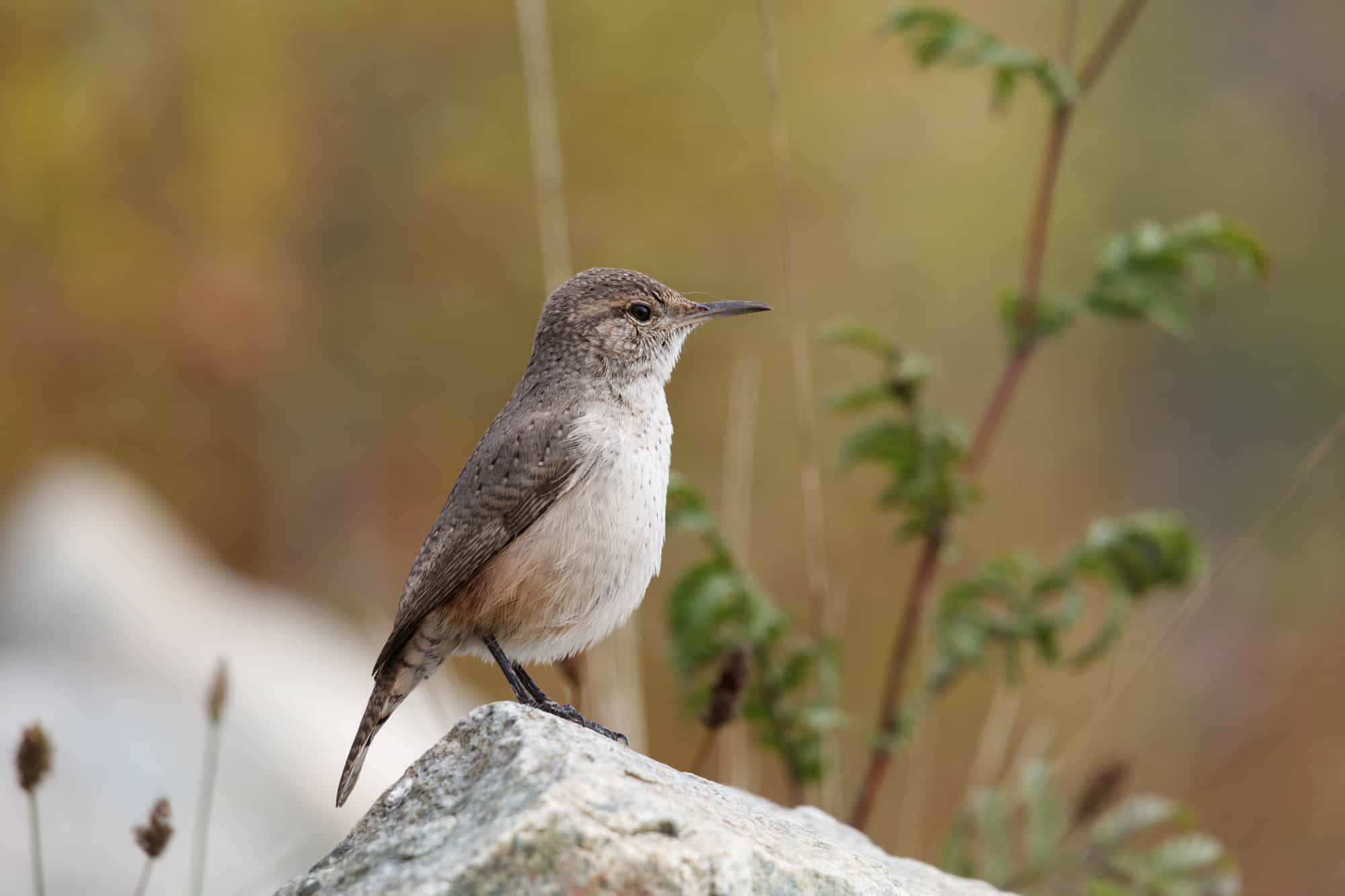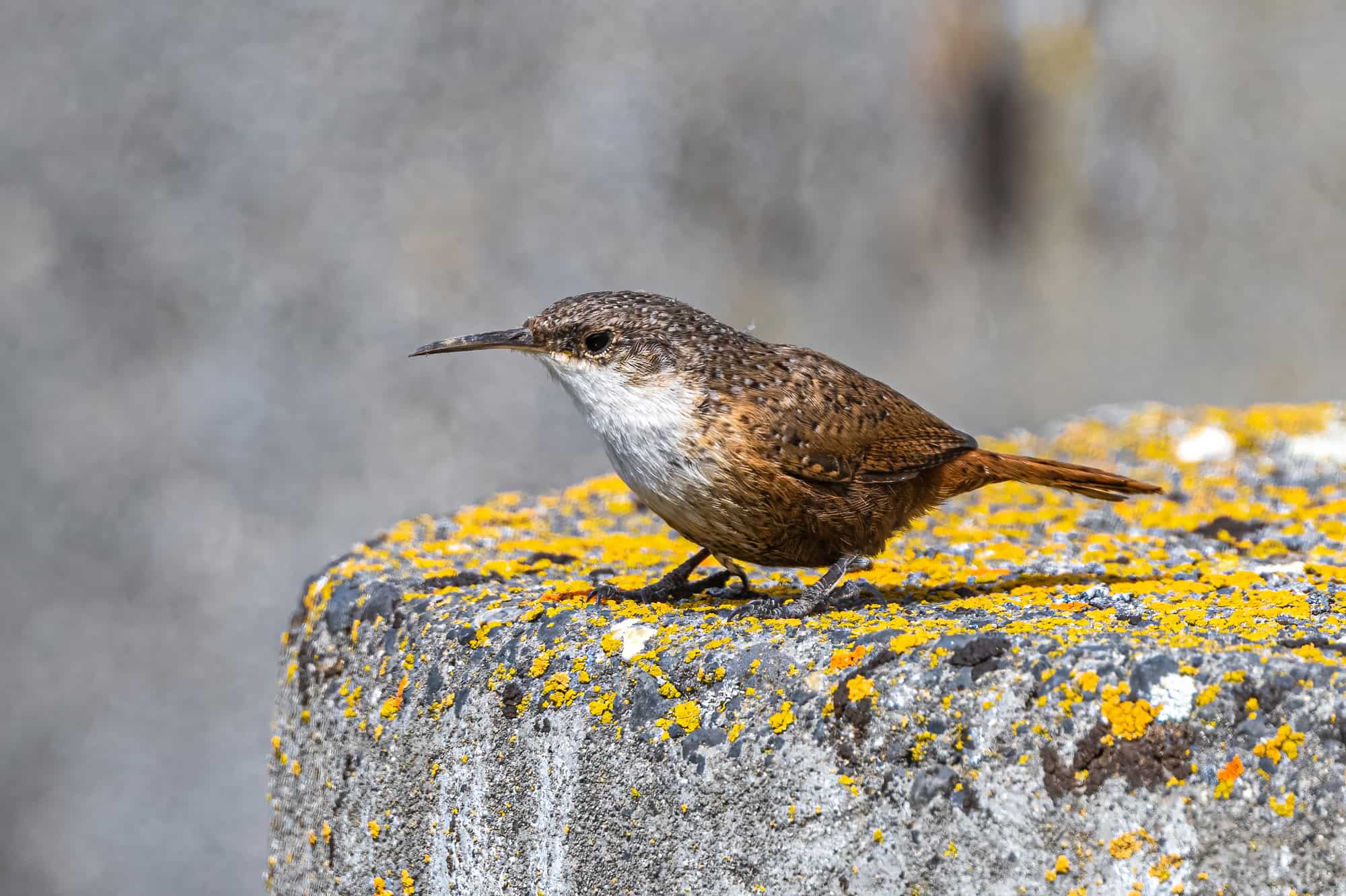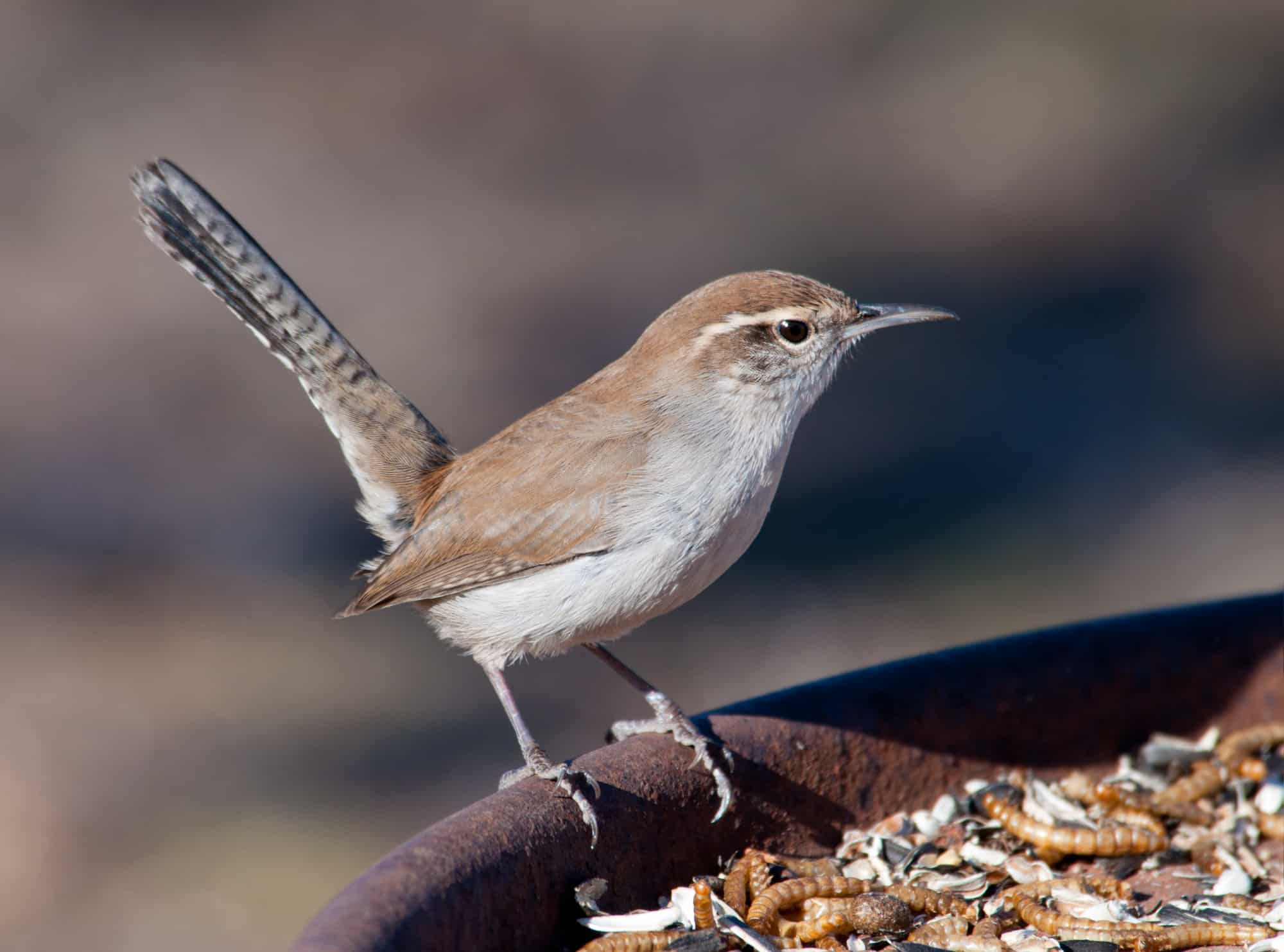There are few birds, in my view, that exude such joy and courage as the diminutive wren. While they may be small and secretive, wrens can easily outcompete much larger birds when it comes to their sheer exuberance and power of voice.
There are eleven species of wren in North America, and Colorado is home to nine of them. Only one is a common bird here, however, and several of the rarer species should be considered prized sightings.
Because Colorado has fairly cold winters, most wrens migrate south for the winter and mainly use the state as a breeding ground.
For the backyard birding enthusiast, wrens can sometimes be attracted to birdhouses. For other wren species, you’ll need to explore rocky cliffs or boggy marshlands to catch a sighting.
Wherever you are, an encounter with a plucky wren can be a thrilling experience. That’s why we’ve made this list describing every wren that you can see if you’re in Colorado.
Wrens In Colorado, Starting With the Most Common
House Wren

- Scientific Name: Troglodytes aedon
- Length: 4.3-5.1 in (11-13 cm)
- Weight: 0.3-0.4 oz (10-12 g)
- Wingspan: 5.9 in (15 cm)
House wrens are the classic little wren of backyards and hedgerows. You’re most likely to see them zipping through the undergrowth in their search of insects, spiders, and other little critters.
These secretive little birds easily make you jump when they suddenly burst into their loud, exuberant, distinctive song! The volume and fervor with which they sing is both surprising and impressive for such a tiny bird.
The adorable house wren is only present during the warmer months in Colorado when they come to breed throughout the state. During winter they retreat to the very southernmost United States and Central America.
Like most wrens, house wrens are cavity nesters and can be attracted to backyards by offering them a birdhouse, including ‘gourd houses’. They also love foraging in brush piles and the weedy corners of the garden.
Rock Wren

- Scientific Name: Salpinctes obsoletus
- Length: 4.9-5.9 in (12.5-15 cm)
- Weight: 0.5-0.6 oz (15-18 g)
- Wingspan: 8.7-9.4 in (22-24 cm)
Rock wrens might be the second most commonly spotted wren in Colorado, but you’re around ten times less likely to see them than house wrens! This species is much larger than a house wren, with a very long bill, long legs, and a short, wide tail.
Its song consists of ringing phrases, each repeated three to six times. Look out for them singing from the top of a rock while bouncing up and down!
Rock wrens are only regularly found in the Western half of America, and in Colorado, they’re chiefly a summer visitor. Very few birds will, however, remain in the southwestern and southeastern corners of the state during winter, too.
Canyon Wren

- Scientific Name: Catherpes mexicanus
- Length: 4.5-6.1 in (11.4-15.4 cm)
- Weight: 0.3-0.7 oz (9.9-18.3 g)
- Wingspan: 7.1-7.9 in (18-20 cm)
The canyon wren is a beautiful but uncommon little wren of the western states and they rarely stray further east than Colorado. You’re most likely to see them on or around vertical cliff faces, often near water.
Canyon wrens have an extremely lovable voice. Their soft, sweet song cascading over the stark mountain landscapes where they live can bring one a palpable sense of solace and refreshment.
These pretty birds have extremely long, slightly curved beaks and distinctive white breasts. The rest of their body is primarily a dark rufous color with subtle black barring.
Their long slender bill is used to probe rock crevices for the insects and spiders that dwell there – their main source of sustenance. They’re present year-round in Southern and Western Colorado.
Marsh Wren

- Scientific Name: Cistothorus palustris
- Length: 3.9-5.5 in (10-14 cm)
- Weight: 0.3-0.5 oz (9-14 g)
- Wingspan: 5.9 in (15 cm)
Unlike the former two species, marsh wrens are present from the Atlantic to Pacific oceans but remain fairly rare in Colorado. The reason for this is that marsh wrens are found almost exclusively in wetlands – a habitat seldom found in The Centennial State.
Unlike the wrens we’ve mentioned so far, marsh wrens don’t nest in cavities but instead build domed nests made from grasses, reeds, and other wetland plants. Male suitors will build several ‘dummy’ nests for females to choose between!
Marsh wrens are mostly a fairly dark rufous color, with black eyebrows and black barred tails. Their noisy, mechanical song is less tuneful than many other wrens, consisting of harsh, rattling trills.
What their song lacks in quality is made up for in quantity, and marsh wrens may even sing right through the night in the breeding season! Their song is your best chance to locate and identify these otherwise inconspicuous birds.
Although it’s rare to see any type of wren in Colorado during winter, the marsh wren is one of the more likely species to encounter here during the colder months.
Bewick’s Wren

- Scientific Name: Thryomanes bewickii
- Length: 5.1 in (13 cm)
- Weight: 0.3-0.4 oz (8-12 g)
- Wingspan: 7 in (17.8cm)
Bewick’s wren could be confused for a house wren, except they have a slightly longer body and prominent white eyebrows. They also have a longer tail which they’ll often flick and fan, revealing its white corners.
Bewick’s wren is a common bird in the far southwest of the United States, but make a fairly rare find in Colorado which lies at the edge of their range.
You’re most likely to find these energetic birds hurrying around brushy habitats looking for insects and spiders. When they’re hungry, however, they’re one of the few wrens that will also visit bird feeders to take dried fruit and seeds.
An interesting fact about Bewick’s wren is how much their song varies from place to place. But typically, their song is a mix of harsh, mechanical trills with a few sweet, tuneful notes thrown in!
Winter Wren

- Scientific Name: Troglodytes hiemalis
- Length: 3.1-4.7 in (8-12 cm)
- Weight: 0.3-0.4 oz (8-12 g)
- Wingspan: 4.7-6.3 in (12-16 cm)
Now we move on to our last few wrens, all of whom are incredibly rare in Colorado.
Winter wrens are so-called because they’re only seen in most of the US during the colder months. In spring and summer, most of them migrate to Canada or high mountains to breed.
But these eastern birds are also seldom found this far out west and could almost be treated as an accidental vagrant in Colorado. You’re fractionally more likely to see them here during the winter than in summer, but chances around the year are very slim!
If you were to see a winter wren here, it’d most likely be in the damp, shady habitat, perhaps in dense woodland near a stream. These tiny birds are most often seen scurrying through brush piles or tangled branches in search of the insects that make up the bulk of their food.
Carolina Wren

- Scientific Name: Thryothorus ludovicianus
- Length: 4.7-5.5 in (12-14 cm)
- Weight: 0.6-0.8 oz (18-22 g)
- Wingspan: 11.4 in (29 cm)
With a wingspan of nearly a foot across, Carolina wrens are the largest wren on our list for Colorado, but are an extremely rare sighting here.
As their name suggests, Carolina wrens are more a bird of the eastern states and are only reported by around one in a thousand bird watchers this far out west.
As well as being the largest, the Carolina wren is also probably the most colorful in Colorado. Their rusty-pink underside, long bill, and striking white eyebrow all make this species one the most ornate of all wrens in America.
The song of this pretty wren is a tuneful repetition of a simple phrase, while females will also sometimes respond with long, buzzing chatter.
Pacific Wren

- Scientific Name: Troglodytes pacificus
- Length: 3.1-4.7 in (8-12 cm)
- Weight: 0.3-0.4 oz (8-12 g)
- Wingspan: 4.7-6.3 in (12-16 cm)
As you’d expect, the Pacific wren’s range is confined mostly to the Pacific coastal region and can be found from California to the western Alaskan islands. They’re very rarely found this far inland.
If you’re thinking that the Pacific wren looks very similar to the winter wren, you’re not alone! These two birds were thought to be the same species until 2008 and were once also thought to be synonymous with the Eurasian wren (Troglodytes troglodytes).
Their song is slightly faster and less musical than their eastern relatives, but Pacific wrens behave much like winter wrens, preferring the same damp, shady habitats to forage about in.
Sedge Wren

- Scientific Name: Cistothorus stellaris
- Length: 3.9-4.7 in (10-12 cm)
- Weight: 0.3 oz (7-10 g)
- Wingspan: 4.7-5.5 in (12-14 cm)
The sedge wren is an extremely tiny bird with a short bill and tail. It has a pale, sandy, cinnamon color and boldly streaked wings.
Sedge wrens enjoy life in damp domains such as sedge marshes and boggy meadows but rarely overlap with the marsh wren which prefers even wetter habitats.
It’s also quite likely that the larger, more aggressive marsh wren wouldn’t accept its presence in their territories.
Sedge wrens are exceptionally difficult to spot and rarely stray into the western states, so it’s extremely unusual to see them in Colorado. If you do, try and get a photo and send it to a local wildlife authority such as New Colorado Naturalist.
One That Got Away!
Ok, there’s one more wren that you could conceivably bump into Colorado!
America’s largest wren, the cactus wren, almost never ventures this far north but was spotted in Colorado in 2018. As the climate changes, they could be seen in the state more often, so keep your eyes peeled!
Conclusion
It’s possible to see 9 wren species in Colorado, although many of them are incredibly rare. Except for house wrens, the others are seldom seen and should be considered a privilege to encounter.
Wrens are such a fun, energetic family of birds to witness in the wild, and a few species can also be attracted to your backyard by offering them an appropriate nest box such as a gourd birdhouse.
Wrens aside, there have been more than 500 other species of bird reported in Colorado! We’ve compiled a list of the very best of them in our fascinating Birder’s Guide to The Centennial State.

